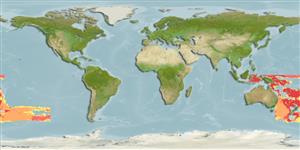Classification / Names
Noms communs | Synonymes | Catalog of Fishes (gen., sp.) | ITIS | CoL | WoRMS | Cloffa
Actinoptérygiens (poissons à nageoires rayonnées) >
Scorpaeniformes (Scorpionfishes and flatheads) >
Scorpaenidae (Scorpionfishes or rockfishes) > Scorpaeninae
Etymology: Phenacoscorpius: Greek, phenax, -akos = deceptive + Greek, skorpion = scorpion (Ref. 45335); longilineatus: Name from Latin word meaning long line, referring to the long lateral line, associated with the greatest
number of pored lateral-line scales in the genus.
Environnement / Climat / Gamme
Écologie
; marin bathypélagique; profondeur 345 - 1089 m (Ref. 92845). Deep-water, preferred ?
Southwestern Pacific: New Caledonia and New Zealand.
Taille / Poids / Âge
Maturity: Lm ? range ? - ? cm
Max length : 10.5 cm SL mâle / non sexé; (Ref. 92845)
Description synthétique
Morphologie | Morphométrie
This species is distinguished by the following set of characters: pectoral-fin rays 16-18 (mode 17), middle rays branched in young and adults; pored lateral-line scales 8-18 (mode 12), with last pored scale situated from below base of seventh spine to below base of fourth dorsal-fin soft� rays; scale rows in longitudinal series 50-52; gill rakers 18-21 (mode 20); no slit behind fourth gill arch; palatine teeth present; second preopercular spine always absent; nuchal and parietal spines distinct; suborbital spines in young and adults 4-6 (mode 5) and in larger adults 6-7; nape and anterior part of body strongly arched in adults of over ca. 80 mm SL; relatively long postnuchal-spine length, 5.0-9.7% (mean 7.2%) of SL; relatively short caudal fin length, 2.4-26.7% (mean 23.4%) of SL; black spots on posterior half of caudal peduncle 1-5 (mode 2); body usually uniformly whitish without distinct dark saddles in preserved specimens (Ref. 92845).
Life cycle and mating behavior
Maturité | Reproduction | Frai | Œufs | Fécondité | Larves
Motomura, H., R. Causse and C.D. Struthers, 2012. Phenacoscorpius longilineatus, a new species of deepwater scorpionfish from the Southwestern Pacific Ocean and the first records of Phenacoscorpius adenensis from the Pacific Ocean (Teleostei: Scorpaenidae). Species Diversity 17:151-160. (Ref. 92845)
Statut dans la liste rouge de l'IUCN (Ref. 115185)
CITES (Ref. 94142)
Not Evaluated
Menace pour l'homme
Harmless
Utilisations par l'homme
Pêcheries:
Plus d'informations
PaysZones FAOÉcosystèmesOccurrencesIntroductionsStocksÉcologieRégime alimentaireÉléments du régime alimentaireConsommation alimentaireRation
Noms communsSynonymesMétabolismePrédateursÉcotoxicologieReproductionMaturitéFraiFéconditéŒufsDéveloppement de l'œuf
Taille/ÂgeCroissanceLongueur-poidsLongueur-longueurFréquences de longueursMorphométrieMorphologieLarvesDynamique des populations larvairesRecrutementAbondance
RéférencesAquacultureProfil d'aquacultureSouchesGénétiqueFréquences alléliquesHéritabilitéPathologiesTraitementMass conversion
CollaborateursImagesStamps, CoinsSonsCiguateraVitesseType de nageSurface branchialeOtolithesCerveauxVision
Outils
Articles particuliers
Télécharger en XML
Sources Internet
